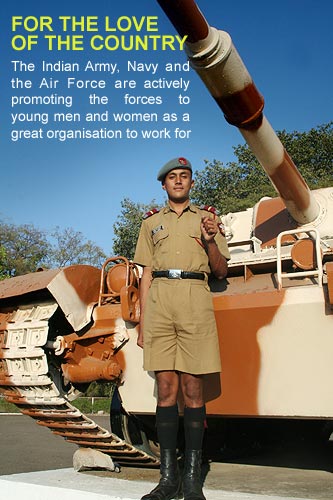
In a classroom, a group of young men, in crew-cuts, with number tags strapped to their chests are addressing each other by numbers. "201" one calls. The person wearing the number responds: he steps forward. This is a mock exercise explains 201. "We are practising for the Services Selection Board. There, at the SSB, you are called by numbers not names."
Number 201 is Shantanu Ghatak, an Economics student in Delhi School of Economics, Delhi University. Standing next to him is 573, well -- Ashutosh Tiwari, a social worker from Allahabad who has come to Delhi for a week to prepare for the SSB.
"It is my dream to join the Indian Army, to serve the country."
Joining the 14-lakh-strong armed forces has, indeed, become the dream of many young men and women. This year alone an additional 1.5 lakh applicants have applied for the National Defence Academy (NDA) entrance exams says Major General M N Kashid, Additional Directorate, Recruiting.
Surely, this year there's more enthusiasm for the armed forces amongst the youth. The applications for the Combined Defence Services Examination (CDSE) are still on their way (the closing date was May 25) but the officials are optimistic.
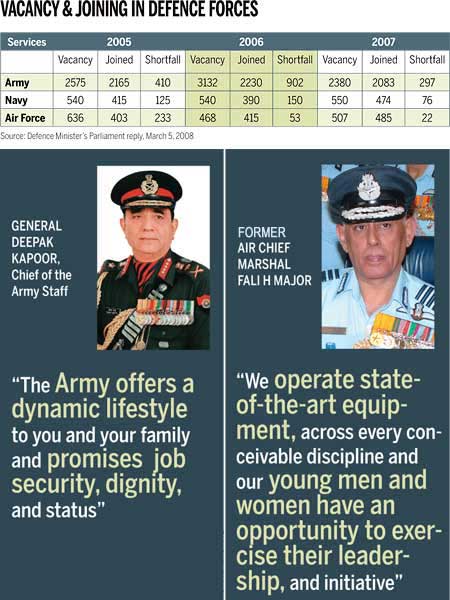
The rise in the number of applications is good news for the forces as for the last few years there has been a shortfall in the recruitments into the Army, Navy and the Air Forces (see adjacent table).
Although there have been movies such as Farhan Akhtar's Lakshya showing life in the Army; even the Indian Navy collaborated with the National Geographic Channel (NGC) to launch Mission Navy: Lehron Ke Sartaj where close to 50,000 civilians from all over the country applied, not many people were still joining the armed forces.
But the economic slowdown has proved to be a blessing. "The spate of layoffs witnessed in private sectors has shaken people's sense of security and confidence in the private sector," says a senior Army official. Now job security is more important than fat salaries given by the multinationals. "We give pay slips not pink slips," says Col. Gill.
And there's no doubt the Sixth Pay Commission has made careers in the Defence forces lucrative. While the stipend of an Officer Cadet now is Rs 21,000, up from Rs 8,000 before the Sixth Pay Commission, the basic salary of Officers for each of the wings has gone up by 40 per cent. (please refer to the table above on the salary structure for Officers). Now the salary of a Lieutenant in the Army or a Sub Lieutenant in the Navy or a Flying Officer in the Air Force would be around Rs 35,000. But the good part is that if you were to add other allowances, this figure could easily go up to Rs 45,000.
"This is one of the best times to the join the armed forces. The salaries are very good and the forces are getting modernised," says Wing Commander Tarun Kumar Singha, India Air Force (IAF) spokesperson. "And once the Ajay Vikram Singh Committee comes out with its report then young officers will have quicker promotions," he adds.
But Col. Gill is of the view that the reason to join the forces has to be beyond money and perks. "People join the forces for a lifestyle. The armed forces are a different experience altogether. They give you inner strength, and no other organisation can do that for you."

To woo young men and women who are opting for lucrative jobs in the private sector, the government is considering a proposal of the three services for making Short Service Commission (SSC) entries more attractive.
In this regard measures being considered include payment of lump sum amount of Rs 1 lakh per annum for the first 10 years of service and Rs 2 lakh per annum for up to 14 years. There is also provision of study leave of two years to those SSC officers who have not undergone Post Graduation while in service.
Besides, there will be concessions for appearing in the Civil Services Examinations such as reduction in number of papers from nine to seven and age relaxation of 10 years for SSC officers to compete.

To make up for the shortfall, the armed forces are encouraging women to join the services. Till now, eligible women were being recruited as Short Service Commission officers but now SSC women officers can apply for Permanent Commission (PC).
This option is open for SSC women officers in Education and Judge Advocate General (JAG) in the Army; Law, Education and Naval Architecture in the Navy and Education, Accounts and Administration (legal branch) in the Air Force. But this scheme is applicable to those who joined after September 2008.
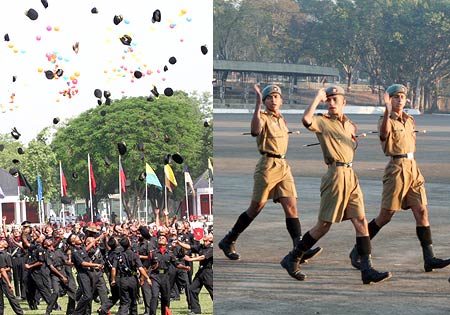
The Army, Navy and the Air Force together have taken up several initiatives to pitch the armed forces as a great organisation to work for.
The Army and the Navy soon will have an E-recruitment feature on their respective websites wherein surfers can fill up the application forms online and send it. "This way we will get enough information on the candidate and even if the candidate does not qualify this time for some reason, we can still be in touch, mailing relevant material till the time he or she is eligible to apply," says Major General Kashid.
Army: So that prospective applicants can truly assess whether they are suited to join the forces, the Additional Directorate of Recruiting has introduced an online psychology test on its website https://joinindianarmy.nic.in/. Col. Gill's advice for the test is that one shouldn't lie or say the expected things, but rather respond honestly. "There are very experienced psychologists at the SSB, so even if you lie in this test, you will be caught at the SSB." So the best thing is, he says, "is to be honest, truthful and original because those are the qualities that we value above anything else!"
In addition, in July 2009 the Army will launch a special scheme for women wherein women studying in the final year of their engineering degrees can also apply to the Army under the University Entry Scheme (UES), which till now was open only for men. After a screening interview conducted by a team of Army Officers, selected women candidates could then directly go for the SSB interview without having to appear for an entrance test. "Last year, only one woman technical graduate was selected in the Army," says Major General Kashid. "The shortfall in the manpower in the Army is in the technical and graduate side; the 10+2 entry seats are usually full." he observes.
Navy: Meanwhile the Cabinet Committee on Security has approved enhancement of the academic curriculum at the Naval Academy from the existing BSc to BTech and this would start with the first batch joining the new Naval Academy at Ezhimala, Kerala, in July 2009. Thus, Officer Cadets would undergo a four-year BTech programme in Electronics, Communication and Information Technology. This degree would be awarded by Jawaharlal Nehru University (JNU). The new Naval Academy in Ezhimala will conduct the BTech courses. The new Academy is spread over an area of 2452 acres of costal upland and being built at a cost of around Rs 700 crore. The academy will now accommodate 750 cadets.
Air Force: Since 2006, the IAF has been conducting Fast Track Selection at various college campuses across the country, including the North East. "North East is a low response area," says Wing Commander Bakshi, Joint Director Personnel Officers (Publicity). Under this scheme, students in their final year of their degree course can apply. A team of Air Force Officers then conducts a screening test at a designated place in the campus of which students are informed much earlier. Selected candidates proceed for SSB. "A big advantage of this scheme is that it reduces the induction time into the Air Force from the normal nine to ten months to three months," says Wing Commander Bakshi.
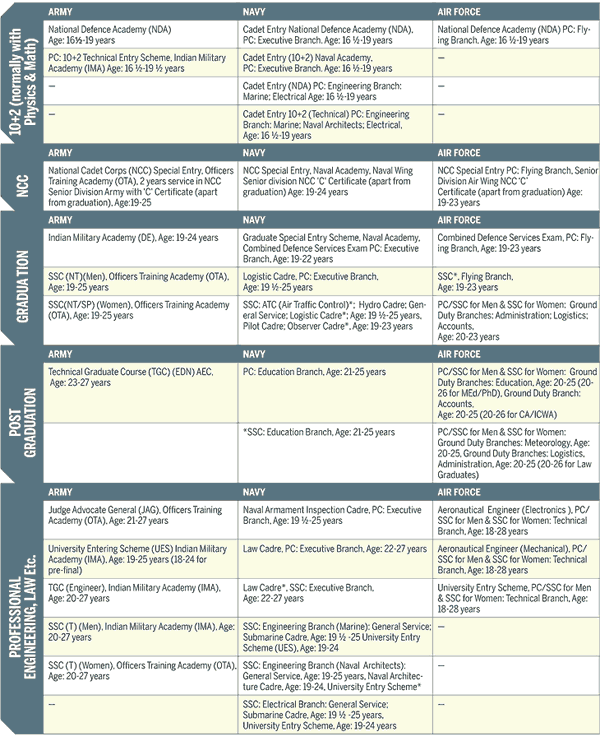
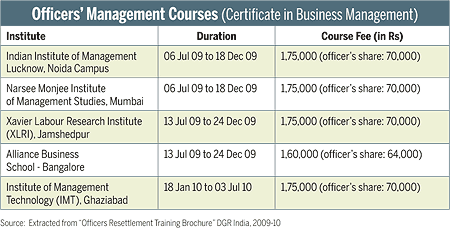
"People are still not fully aware of the opportunities within the forces," says Indian Navy's spokesperson Commander Nirad K Sinha. Sure it is common knowledge that Officers get ration and furnished accommodation in prime locations, that housing and car loans are given on a lower rate of interest, that medical facilities are free, but it is little known that the Forces also give you the chance to go sailing around world!
"Think of anything and it is possible in the armed forces," says Group Training Officer, Retired Commander Satinder Singh. So you could go to the Artic, fly around the world or even be a part of a motorcycle rally to Leh and Ladakh. "There's plenty of adventure for those who seek to dare!" says Wing Commander Singha. "One day my course-mate called to say he was learning mountaineering and the next thing I know he has scaled the Everest!"
Officers also get the opportunity to travel the world on peacekeeping missions. And when it's time to take a break from all the frenetic activity, the forces offer 60 days' annual leave and 20 days' casual leave. But let us not forget reminds Commander Sinha that the Defence provides one of the best educational training in the country. A list of the training institutes can be seen on the website of the Ministry of Defence https://mod.nic.in/rec&training/welcome.html.
Besides, Officer Cadets after completion of their studies from their respective academies are awarded degrees from JNU. At the moment, there are four degrees being awarded: Bachelor of Arts (BA), Bachelor of Science (BSc), BSc in Computer Science and Bachelor of Engineering. However, from 2013 onwards a BTech degree would be awarded to naval Officers in lieu of the BSc degree from JNU. Besides, officers can apply for a two-year paid leave to study in India or abroad.
Not that just, there's opportunity for retiring officers to upgrade their skills and qualifications. The Directorate General Resettlement (DGR), Ministry of Defence has tied up with a number of premiere B- Schools such as the Indian Institute of Management (IIM), Management Development Institute (MDI) and Narsee Monjee Institute of Management Studies to resettle Short Service Commission (SSC) as well as Permanent Commission (PC) officers. "This is a good opportunity for outgoing officers to upgrade their management skills and be better equipped for the private sector," says Commander Sinha. (Refer to table above for a detailed list on the courses). "In every possible way our endeavour is to give the best we can to the Officers who have served the country," says Col. Gill.
To this long list, Shantanu adds 'Bharat Darshan'. "An all-expense paid trip for 20 years! And I will get to try different Indian cuisines." Then he pauses, "But of course, with this I will have the chance to make a difference." Ashutosh from Rajasthan nods. Would it give him happiness if he makes it to the Forces? "Satisfaction," Ashutosh says, "satisfaction is a feeling that comes after happiness."